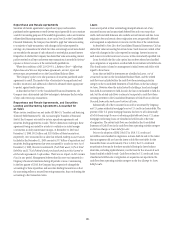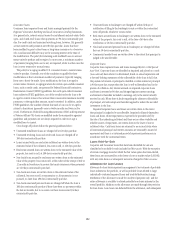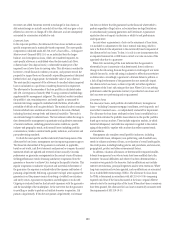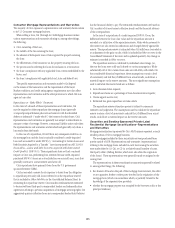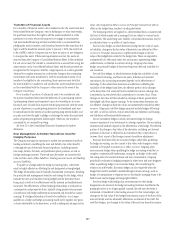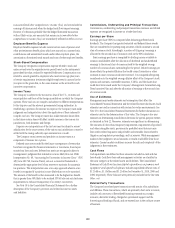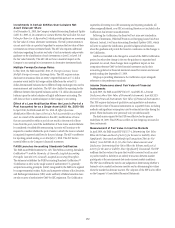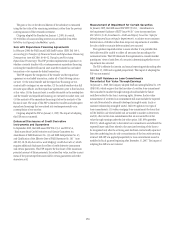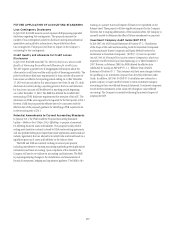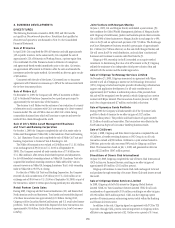Citibank 2010 Annual Report Download - page 170
Download and view the complete annual report
Please find page 170 of the 2010 Citibank annual report below. You can navigate through the pages in the report by either clicking on the pages listed below, or by using the keyword search tool below to find specific information within the annual report.168
in Accumulated other comprehensive income (loss) and are included in
earnings of future periods when the hedged cash flows impact earnings.
However, if it becomes probable that the hedged forecasted transaction
will not likely occur, any amounts that remain in Accumulated other
comprehensive income (loss) are immediately reflected in Other revenue.
Employee Benefits Expense
Employee benefits expense includes current service costs of pension and
other postretirement benefit plans, which are accrued on a current basis,
contributions and unrestricted awards under other employee plans, the
amortization of restricted stock awards and costs of other employee benefits.
Stock-Based Compensation
The Company recognizes compensation expense related to stock and
option awards over the requisite service period based on the instruments’
grant date fair value, reduced by expected forfeitures. Compensation cost
related to awards granted to employees who meet certain age plus years-
of-service requirements (retirement eligible employees) is accrued in the
year prior to the grant date, in the same manner as the accrual for cash
incentive compensation.
Income Taxes
The Company is subject to the income tax laws of the U.S., its states and
municipalities and those of the foreign jurisdictions in which the Company
operates. These tax laws are complex and subject to different interpretations
by the taxpayer and the relevant governmental taxing authorities. In
establishing a provision for income tax expense, the Company must make
judgments and interpretations about the application of these inherently
complex tax laws. The Company must also make estimates about when
in the future certain items will affect taxable income in the various tax
jurisdictions, both domestic and foreign.
Disputes over interpretations of the tax laws may be subject to review/
adjudication by the court systems of the various tax jurisdictions or may be
settled with the taxing authority upon examination or audit.
The Company treats interest and penalties on income taxes as a
component of Income tax expense.
Deferred taxes are recorded for the future consequences of events that
have been recognized for financial statements or tax returns, based upon
enacted tax laws and rates. Deferred tax assets are recognized subject to
management’s judgment that realization is more likely than not. FASB
Interpretation No. 48, “Accounting for Uncertainty in Income Taxes” (FIN
48) (now ASC 740, Income Taxes), sets out a consistent framework to
determine the appropriate level of tax reserves to maintain for uncertain
tax positions. This interpretation uses a two-step approach wherein a tax
benefit is recognized if a position is more likely than not to be sustained.
The amount of the benefit is then measured to be the highest tax benefit
that is greater than 50% likely to be realized. FIN 48 also sets out disclosure
requirements to enhance transparency of an entity’s tax reserves.
See Note 10 to the Consolidated Financial Statements for a further
description of the Company’s provision and related income tax assets
and liabilities.
Commissions, Underwriting and Principal Transactions
Commissions, underwriting and principal transactions revenues and related
expenses are recognized in income on a trade-date basis.
Earnings per Share
Earnings per share (EPS) is computed after deducting preferred stock
dividends. The Company has granted restricted and deferred share awards
that are considered to be participating securities, which constitute a second
class of common stock. Accordingly, a portion of Citigroup’s earnings is
allocated to the second class of common stock in the EPS calculation.
Basic earnings per share is computed by dividing income available to
common stockholders after the allocation of dividends and undistributed
earnings to the second class of common stock by the weighted average
number of common shares outstanding for the period. Diluted earnings per
share reflects the potential dilution that could occur if securities or other
contracts to issue common stock were exercised. It is computed after giving
consideration to the weighted average dilutive effect of the Company’s stock
options and warrants, convertible securities, T-DECs, and the shares that
could have been issued under the Company’s Management Committee Long-
Term Incentive Plan and after the allocation of earnings to the second class
of common stock.
Use of Estimates
Management must make estimates and assumptions that affect the
Consolidated Financial Statements and the related footnote disclosures. Such
estimates are used in connection with certain fair value measurements. See
Note 25 to the Consolidated Financial Statements for further discussions on
estimates used in the determination of fair value. The Company also uses
estimates in determining consolidation decisions for special-purpose entities
as discussed in Note 22. Moreover, estimates are significant in determining
the amounts of other-than-temporary impairments, impairments of goodwill
and other intangible assets, provisions for probable losses that may arise
from credit-related exposures and probable and estimable losses related to
litigation and regulatory proceedings, and tax reserves. While management
makes its best judgment, actual amounts or results could differ from those
estimates. Current market conditions increase the risk and complexity of the
judgments in these estimates.
Cash Flows
Cash equivalents are defined as those amounts included in cash and due
from banks. Cash flows from risk management activities are classified in
the same category as the related assets and liabilities. The Consolidated
Statement of Cash Flows line item Capital expenditures on premises and
equipment and capitalized software includes capitalized software costs of
$1.2 billion, $1.1 billion and $1.2 billion for December 31, 2010, 2009 and
2008, respectively. These balances were previously included in the line item
Other, net.
Related Party Transactions
The Company has related party transactions with certain of its subsidiaries
and affiliates. These transactions, which are primarily short-term in nature,
include cash accounts, collateralized financing transactions, margin
accounts, derivative trading, charges for operational support and the
borrowing and lending of funds, and are entered into in the ordinary course
of business.





